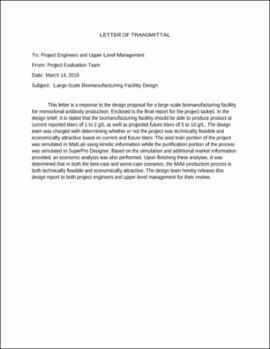| dc.contributor.author | Finch, Marissa | |
| dc.contributor.author | Eastep, Carley | |
| dc.contributor.author | Mullins, Duncan | |
| dc.date.accessioned | 2021-03-25T18:40:23Z | |
| dc.date.available | 2021-03-25T18:40:23Z | |
| dc.date.issued | 2019-05-10 | |
| dc.identifier | oksd_FinchEastepMullins_HT_2019 | |
| dc.identifier.uri | https://hdl.handle.net/11244/329051 | |
| dc.description.abstract | Enclosed in this report is the feasibility study of a large-scale biomanufacturing facility. The study addresses the technical feasibility and economic attractiveness of the production of Monoclonal Antibodies from Chinese Hamster Ovary Cells in varying titers ranging from 1g/L to 10 g/L of MAb. | |
| dc.description.abstract | The proposed design follows the manufacturing process explicitly described in the design brief. The initial part of the design process that includes the seed train and production bioreactors was simulated and optimized in MatLab using the process’ kinetic information. It was determined that three simultaneous trains of increasing reactor size up to 30,000 L needed to be run in order to achieve the minimum amount of MAb needed per year. The second part of the design process that includes the purification train was simulated and optimized in SuperPro Designer. It was determined that when the titers increased over 5 g/L, two purification trains are required in order to meet recovery specifications. The results from both simulations proved the proposed design is technically feasible. The design requires the purchase of multiple types of disposable or non-disposable bioreactors, multiple holding and mixing vessels, several resin columns, and multiple storage vessels and waste tanks for an initial capital investment of roughly $172 million. | |
| dc.description.abstract | Construction of the facility will begin in 2019 with operation beginning mid-year 2020. The plant would operate at the titer 1 g/L starting in 2020 and increase up to the titer of 10 g/L as needed. The plant size is designed for up to 10 g/L, so the yearly utility costs are estimated around $2,000,000 per year, while the raw materials and consumables costs are around $134 million per year. The total project evaluation life is 25 years assuming a tax rate of 30%, a minimum rate of return of 15%, and an escalation rate of 2%. The production has an annual revenue of over $6 billon in 2019 dollars. Using these economic metrics, it was determined that the net present value of project is $32 billion and the DCFROR is 22.3%, with a payback period of 0.045 years. Based on these results, the project is economically attractive and should continue into construction. | |
| dc.description.abstract | The capital cost of the project has the biggest impact on the economic viability of the proposed process. If the capital cost increases by 25%, the discounted rate of return will be 17.9%. If the capital cost decreases by 25%, the discounted rate of return is 29.8%. However, even during best-case and worst-case analysis, the DCFROR was still greater than the initial rate of return proving the process to be economically attractive. | |
| dc.format | application/pdf | |
| dc.language | en_US | |
| dc.relation | oksd_black_HT_2019.pdf | |
| dc.relation | oksd_MackeyPeters_HT_2019.pdf | |
| dc.relation | oksd_macnaughton_HT_2019.pdf | |
| dc.rights | Copyright is held by the author who has granted the Oklahoma State University Library the non-exclusive right to share this material in its institutional repository. Contact Digital Library Services at lib-dls@okstate.edu or 405-744-9161 for the permission policy on the use, reproduction or distribution of this material. | |
| dc.title | Large-scale biomanufacturing facility design | |
| osu.filename | oksd_FinchEastepMullins_HT_2019.pdf | |
| osu.accesstype | Open Access | |
| dc.type.genre | Honors Thesis | |
| dc.type.material | Text | |
| thesis.degree.discipline | Chemical Engineering | |
| thesis.degree.grantor | Oklahoma State University | |
